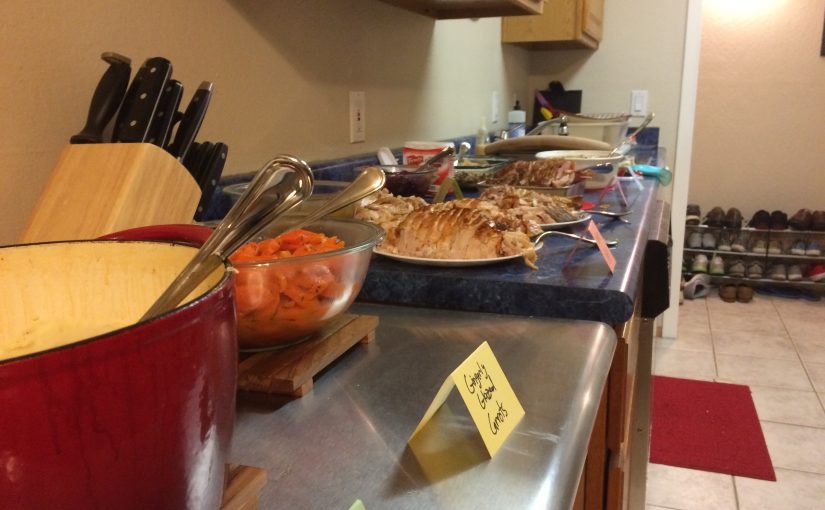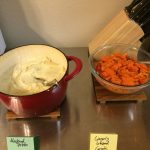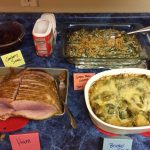It only took 6 tries, but this year, I finally served a Thanksgiving dinner on-time, and more importantly, I felt totally relaxed. Although I have prepared gantt charts for the past several years, I always ended up behind schedule and needed to draft additional sous chefs to finish dishes while I was carving the turkey. This year, I was actually ahead of schedule, and like years past, I learned a few things that made it all happen.
So, here’s what your Thanksgiving could look like following my chart and the lessons below.
1. Prepare the space beforehand.
I am proud that I can serve dinner to almost 20 people at my place not only because I can make enough food but also because I can make enough space. Just to cram everyone in without getting elbows in neighboring piles of mashed potatoes, we have to rearrange our living room furniture and make space in the kitchen for serving. And we have to clean everything to give the illusion of order.
Previously, I took care of this while cooking. For example, after putting the turkey in the oven, I would dash over to my checklist to figure out what rooms still needed to be vacuumed. All of that preparation, however, can happen well ahead of the dinner party itself. Unlike with turkey, no one is going to complain if the sofa has been sitting out for 24 hours and gotten a little cold.
2. Print out recipes onto paper.
Despite pretending to be a luddite from time-to-time, I am a digital native both in and out of the kitchen. We have a shelf of cookbooks, but I find it difficult to use those instead of online recipes. Recipes online are easily searchable with reviews and tips from other chefs. You can load all of them up onto an iPad and easily flip between them.
But then you also have to unlock your tablet when it goes to sleep. And the touch input doesn’t always work well with wet fingers. And even if it does work, you just left a smudge of cranberry on your precious Netflix-watching device. And then you have to switch tabs to find the recipe and scroll to the right step.
Thankfully, I recently discovered a different medium that doesn’t have any of these problems. Some ingenious people figured out how to pound wood pulp into sheets and transfer digital information onto them with ink. Paper is pretty fantastic.
In a messy kitchen like mine, I don’t have to worry about splashing oil on printouts because I will throw it away in a few hours anyways. I can leave the gravy recipe next to the saucepan with the gravy and have the ice cream recipe on the other counter next to the ice cream maker. I can write down notes on timing or progress through my gantt chart to see what’s left to do.
Now if only I owned a printer that still worked.
3. Plan to get rid of leftovers.
This year, we served Zanbato Thanksgiving on Thursday. On Friday, we had a holiday party. On Saturday, we had a football game. On Sunday, we were already gone to spend the week with Julie’s family. As much as I love creative Thanksgiving leftovers, we didn’t have much time to eat them. And despite that, we still cleaned out the fridge before we left.
First, I made the situation clear to the guests that we needed the food to go. Actually I’m not sure if that made a difference.
First, I got the known scraps like the carcass and vegetable ends into the freezer immediately during prep so they were out of the way. Second, I had supplies so that people could take home leftover plates for a late night snack or other loved ones who couldn’t make it. Third, I froze more uneaten food: specifically, I used my new FoodSaver vacuum sealer to bag the extra ham.
Finally, the leftover sides made it to a Thanksgiving tailgate before the football game on Saturday. That actually took more planning to deliver warm sides to a tailgate on a cold afternoon that was at least a drive and walk away from us. Thank goodness for coolers and ziplock bags of warm water.
4. Pick only recipes that can be kept warm.
Many of my favorite foods taste best when they are freshly cooked. For example, I love to serve stir-fries over noodles or rice. However, they don’t hold up particularly well: the sauce coagulates, and the vegetables get soft. Roasted vegetables are also suspect depending on how they are cooked.
I knew that I should pick make-ahead recipes to ease the day, but I always included one or two recipes to be made fresh. That was definitely a mistake. Even one fresh recipe means that it needs to be in the oven or on stove until the last minute, and those last minutes are best used to carve turkey and keep the rest of the dishes warm in the oven. This year, my oven was down below 300 at 6PM with 3 dishes in there, and I had 3 burners on low with tops on. All I had to do was neatly turn a whole turkey into many smaller pieces.
5. Pick recipes you know.
When I had originally started cooking Thanksgiving dinner for my coworkers, I had two goals in mind. First, I wanted to present an American tradition that people would typically miss, since many were at least transplants and often international. Second, I wanted to try different recipes to broaden my skills and keep things interesting between 2 Thanksgivings.
Since then, the tradition has continued, but I have different reasons for doing it. First, expectations have gotten higher: although my coworkers may have initially come to humor me and hope to avoid food poisoning, I think they’re expecting good food. Second, I have tapped out most of the cuisines that I know well, and I’m not sure that I can do something different.
Now that I’m several years into adult life, I am beginning to understand why my mom cooked the way she did. There are clues that my mom was a real chef: the massive binders of newspaper clippings, a very well-stocked kitchen, and raising 3 children who all enjoy cooking. However, when I talked to my mom about how she picked recipes, she never seemed adventurous. For dessert, she often made cookies because “cake is too much work.” We settled into many repeated recipes, which we enjoyed but weren’t too wacky.
Cooking food for others has an odd payoff structure. Most people are incredibly appreciative of being served at all, so the baseline is actually quite high. That also means there isn’t much upside: your guests don’t see the extra effort for fancy recipes. However, there’s always a risk that things go wrong, and even if your guests deflect, it feels bad to serve burnt food.
So my mom has the right idea: play it safe and cook what you know will make for happy stomach and clean plates. Save the experiments for yourself and significant others who hopefully don’t hold it against you.
Anyways, I know this post is too late for most Thanksgiving this year, but I hope you found something to be thankful for and enjoy your holiday season however you see fit!






